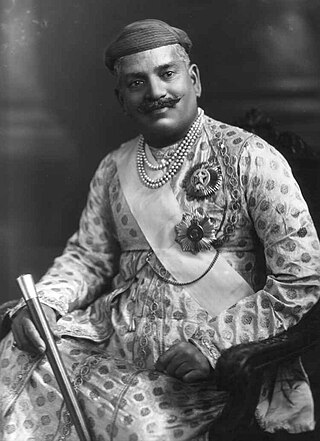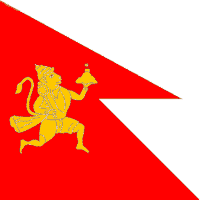The rulers of Jath belonged to the Dafle dynasty. The last ruler Vijayasingh Rao Ram Rao took the title of 'Raja'. [3]
Raja
892 - 1928 Meherban Shrimant Ramrao II Amritrao [Aba Sahib] Dafle, Desmukh of Jath. b. at Umraun, 11 January 1886, as Bowanjirao Parashuramrao Dafle, fourth son of Shrimant Sardar Parashuramrao Madhavrao Dafle, of Umraun, educ. Rajaram Coll., Kolhapur and Rajkumar Coll., Rajkot. Adopted by his maternal great aunt, Shrimant Akhand Soubhagyavati Lakshmibai Raje Sahib Dafle, widow of Shrimant Amritrao Ramrao Sahib Dafle, Desmukh of Jath, 1892. Installed on the gadi, at the City Palace, Jath, 13 January 1893. Reigned under the Regency of his adopted mother until her death on 28 March 1897, and then under a Council of Regency appointed by the GOI. He came of age and was formally invested with full ruling powers at Ramdas Palace, Jath, 11 January 1907. Resumed Daflepur on the death of Rani Lakshmibai in 1917. A modern and benevolent ruler who established several primary and secondary schools, introduced local self-government, free medical services, banking facilities for farmers, constructed several irrigation tanks and public buildings. He also rendered useful services to the Crown during the Great War and established a Jath Company of the Mahratta Light Infantry, within the territorial army scheme. Presdt All-India Mahratta Educational Conference at Nagpur. Mbr Deccan Education Soc, Willingdon Sports Club (Bombay), etc. m. at the Rajwada, Akalkot, 18 May 1902, Shrimant Akhand Soubhagyavati Bhagirathibai Raje Sahib Dafle (b. at the Rajwada, Akalkot, 16 November 1889), Regent for her son 1928-1929, née Shrimant Putalabai Raje Sahib Bhonsle, second daughter of Meherban Shrimant Shahaji III Raje Bhonsle [Baba Sahib], Raja of Akalkot, by his wife, Shrimant Akhand Soubhagyavati Lakshmibai Raje Sahib Bhonsle, daughter of Shrimant Sardar Narayanrao Dhaibar Killedar, by his wife, the second daughter of H.H. Shrimant Maharaja Sir Khanderao II Gaekwad, Sena Khas Khel Shamsher Bahadur, Maharaja of Baroda, GCSI. He d. at Ramdas Palace, Jath, 14 August 1928, having had issue, four sons and three daughters:
1) Shrimant Pratapsinhrao Ramrao Dafle [Bala Sahib]. b. at Jath, 28 February 1908, but d. of malarial fever, 18 September 1910. 2) The Hon Raja Shrimant Vijaysinhrao Ramrao Raje Dafle [Baba Sahib], Raja of Jath - see below. 3) Shrimant Rajkumar Ajitsinh Ramrao Dafle, MBE (c 8.1.1944). b. at Jath, 15 January 1912, educ. Jath High Sch, Rajaram Coll., Kolhapur, and Univ. of London (BA), and Middle Temple, London. Barr-at-Law. MEC Jath, Police, Education and General Minister 1940-1945, Guardian and Comptroller of the Household to the minor Maharaja of Kolhapur 1945-1947. Rcvd: Silver Jubilee (1935) and Coron. (1937) medals. He had issue, two sons: a) Shrimant Shri Ramrao Ajitsinh Dafle, educ. Rajkumar Coll., Rajkot. b) Shrimant Shri Anilraje Ajitsinh Dafle, educ. Cathedral and John Connon Sch ., Bombay. m. the daughter of Shrimant Yeshwantrao Pirajirao Ghatge [Appa Sahib], of Kagal Senior. 4) Shrimant Rajkumar Udaysinhrao Ramrao Dafle [Bhaiya Sahib]. b. at Jath, 6 March 1920, educ. Shri Ramrao Vidya Mandir, Jath, and Rajaram Coll., Kolhapur. Cmsnd into the RINVR as Sub-Lieut. 1/12/1942, served in WW2, resig. 1945. Hon MSC Jath 1945-1948, Police and Education Minister 1945 - 1947, Army & Political Minister 1947-1948. Rcvd: Coron. (1937), British War (1945), 39/45 & Pacific Stars, British War and India Service (1945) medals. Copyright© Christopher Buyers 1) Shrimant Rajkumari Pramila Raje Sahib Dafle [H.H. Shrimant Akhand Soubhagyavati Maharani Pramila Raje Sahib Pur, Maharani Regent of Dewas Senior]. b. at Jath, 4 August 1910, Regent of Dewas 11 August 1941 – 15 May 1943 and 23 March 1947-27th June 1948. m. at Dewas, 30 December 1926, Major-General H.H. Maharaja Shrimant Sir Shahaji II Bhonsle Chhatrapi Bahadur, Maharaja of Kolhapur, GCSI (b. at Kolhapur, 4 April 1910; d. 9 May 1983), eldest son of H.H. Kshatriya Kulavatana Sapta Sahasra Senapati Pratinidri, Meherban Shrimant Maharaja Tukojirao III Puar, Maharaja of Dewas (Senior), KCSI, by his first wife, H.H. Shrimant Akhand Soubhagyavati Maharani Radhabai Maharaj Sahib Puar, eldest daughter of Colonel H.H. Maharaja Shrimant Sir Shahu Chhatrapati Bahadur, Maharaja of Kolhapur, GCSI, GCIE, GCVO. She d. at Kolhapur, 31 January 2008, having had issue, one son and three daughters - see India (Dewas-Senior) and (Kolhapur).
2) Shrimant Rajkumari Indira Raje Sahib Dafle. b. at Mahableshwar, 7 May 1913, and d. at Shahapur, Belgaum Dist. 23 May 1914.
3) Shrimant Rajkumari Kamala Raje Sahib Dafle [H.H. Sakal Soubhagyavati Sampanna Shrimant Rani Priyamwada Raje Sahiba, Rani of Jawahar]. b. at Jath, 30 August 1915. m. at Jath, 8 May 1938, H.H. Maharaja Shrimant Patangshah V Mukne, Godharma Pratipalak, Raja of Jawahar (b. at Jawhar, 11 December 1917; d. 4 June 1978), younger son of Meherban Shrimant Raja Vikramshah V Mukne, Godharma Pratipalak, Raja of Jawahar, by his wife, Sakal Soubhagyavati Sampanna Shrimant Rani Sagunabai Raje Sahiba, a lady from the Nadge family of Washale, in the Thana dist. She had issue, one son and two daughters - see India (Jawahar)



















